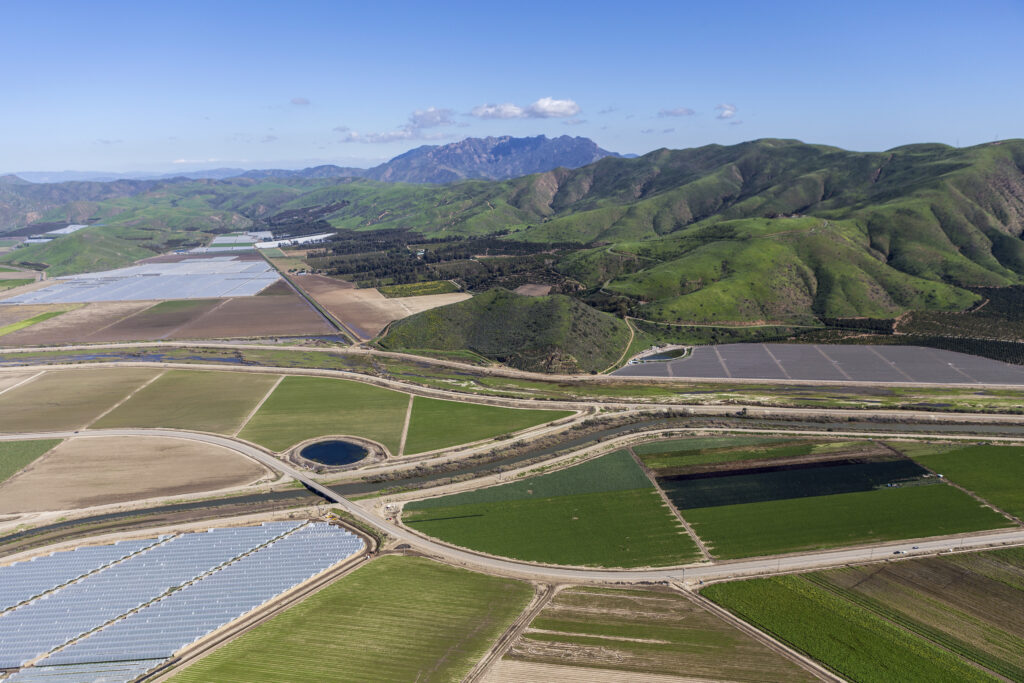
In 2014, California passed a legislative package to work toward making groundwater extraction sustainable over the long term. The law, known as the Sustainable Groundwater Management Act (SGMA), followed decades of over pumping, resulting in dry wells, land subsidence, and seawater intrusion in many parts of the state. A few enclaves throughout California, mostly urban areas, already had groundwater management frameworks as a result of costly and time-consuming adjudication or special and location-specific enabling legislation. But for most of the state’s struggling aquifers, SGMA brought an end to nearly limitless pumping entitlements for overlying landowners.
Early headlines expressed some excitement about the potential for using markets to contain the costs of groundwater conservation. A decade later, what role have groundwater markets actually played in implementing SGMA?
SGMA requires that the state’s groundwater resources be managed sustainably by the early 2040s. Sustainability is defined to mean an end to persistent groundwater drawdown and the avoidance of certain “undesirable results,” including significant reductions in groundwater storage, saltwater intrusion, water quality degradation, land subsidence, and surface water depletion. Under SGMA, development and implementation of plans to achieve this sustainability goal is left to sub-county “groundwater sustainability agencies,” formed under SGMA and composed mostly of representatives from existing water, irrigation, and reclamation districts, cities, and counties. These agencies develop groundwater sustainability plans, which include substantial amounts of research into the hydrologic nature of each local aquifer and rough plans for how to achieve sustainability.
With SGMA now 10 years old, groundwater sustainability agencies are fully formed, and over half of them have received state approval for their sustainability plans. The sets of policies and projects considered in each plan are diverse, and implementation of them remains nascent. Some agencies are attempting to meet their sustainability goals by doing nothing but augmenting water supply; others hope to reduce water demand by increasing efficiency of use or incentivizing fallowing. But a substantial minority of agencies are considering developing groundwater markets by assigning allocations and enabling trade.
Allocations and Accounting
A precursor to setting up a groundwater market is making clear allocations and determining rules for groundwater accounting, neither of which is a straightforward task. Inevitably, deciding how to split the fixed pie of sustainable yield can create political conflict, and the space of potential allocations is constrained by existing California precedent, which SGMA explicitly does not modify. To oversimplify, this precedent means that existing pumpers’ beneficial uses that are “reasonable in light of the competing demands of other overlying users” must be preserved.
For groundwater sustainability agencies designing allocations, this means assigning allocations proportional to acreage, irrigated acreage, or, where such data exists, historic use. Naturally, landowners’ preferences over each scheme will depend on the water intensity of their own land uses vis-a-vis their neighbors. Litigious holdouts have decades of messy case law from which to base a legal objection, an outcome that many agencies have worked hard to avoid—some more successfully than others—through repeated engagement with stakeholders.
Once allocations are settled, groundwater sustainability agencies need to determine a method of accounting for use. The obvious choice is to use well meters and track pumping, but this fails to take into account the fact that some pumped water returns back to the aquifer. Tracked this way, setting the overall allocation equal to sustainable yield would result in more conservation than necessary, but setting the allocation higher would risk overdraft when pumpers change crops or irrigation technologies.
Other emerging techniques use remote sensed measurements of evapotranspiration to establish actual use, but this is necessarily a less precise measurement than simple volumetric pump metering. Beyond tracking use, allocation schemes that consider awarding additional allocation to landowners that actively assist in recharge—for example by constructing recharge basins for storm flows—will need accounting frameworks to make proper awards.
Trading Rules
An additional source of contention is determining rules for what trades are allowed and how they are settled. In 2022, the California Water Commission released a white paper warning that trading schemes need to include safeguards for vulnerable users. The following is an overview of the concerns it noted:
- Trading will affect the spatial or temporal distribution of pumping in a manner that diminishes groundwater-dependent ecosystems, dries shallow wells (especially domestic wells or wells for disadvantaged communities), and exacerbates contaminant plume migration or seawater intrusion
- Small and medium farms will lack the operational capacity to trade effectively
- Large farm operators will wield market power in exchanges
- Small and medium farms may not be able to afford water and remain viable
- Community water systems may not be able to afford allocations to meet basic human needs
The overall tone of the state’s white paper encouraged experimentation with trading schemes but in a highly risk averse and tightly regulated manner. Arguing that groundwater sustainability agencies should “start small”—“conscribed to small geographic areas and short-term, temporary trades”—the commission offered a list of potential policies to deal with the above concerns. To resolve issues of spatial or temporal concentration of pumping, it proposed directional trading restrictions, trading ratios, well-spacing limits, pumping schedules, buffer zones, “special management areas,” and notice requirements. To address potential market power, the commission argued for anonymous trading to prevent buyers from knowing the identity of sellers and vice versa. It also suggested “confining” trading programs to limit trades to buyers and sellers of “similar size.” These specific recommendations are not binding for any groundwater sustainability agency, but they reflect apprehension among some in the state government about the role of water markets in SGMA compliance.
Groundwater is certainly a complex natural resource, and managing a groundwater market as if the resource conforms to a simplified “bathtub” model will result in unintended environmental and social consequences. At the same time, some amount of abstraction will be necessary to make trade practicable; excessive, poorly tailored safeguards run the risk of ballooning the transaction costs of water markets and sharply restricting the scope of mutually beneficial trade.
While markets for common-pool natural resources have succeeded in many domains, they have often suffered for lack of participation in others, especially in markets related to water resources. Market rules that harshly restrict a seller’s pool of potential buyers due to geographic distance or mismatched “sizes” can further stiffen markets that already struggle with liquidity.
Existing and Future Markets
So far, few markets have actually been established under SGMA, and many sustainability agencies that expressed early interest in market development have not yet followed through. Fox Canyon Groundwater Sustainability Agency, which had an early advantage over other agencies thanks to much more thorough data on historical use, set up an operational market with telemetric well metering and simple restrictions on trades applying to a handful of small areas with particular spatial concerns. A few other agencies have allowed for intra-agency water transfers without relying on a centralized exchange. Still, others, including the McMullin Area and Mid-Kaweah agencies, have conducted pilots that may or may not progress into actual programs. But by and large, the significant minority of groundwater sustainability agencies that expressed interest in market development within their sustainability plans have not reported any progress in that endeavor.
Despite little action so far, agencies may still establish markets as SGMA ages further. Though SGMA passed a decade ago, many of the early years of the law involved setting up the agencies, collecting data, and drafting initial sustainability plans. Even critically overdrafted basins—the ones facing the tightest deadlines under SGMA implementation—have not yet had to submit their five-year follow-ups because their plan submission deadline was not until 2020.
For a groundwater sustainability agency facing the potential political turmoil that often accompanies new market establishment and needing to assemble an entire suite of overdraft responses, it could be perfectly sensible to punt market development to a later date. This is doubly true given the seeming skepticism of some state-level actors reflected in the California Water Commission white paper. However, prompted in part by that paper, the Department of Water Resources is working on guidance to support market design. Hopefully, this will deliver some needed clarity and synthesize transportable lessons from the few groundwater sustainability agencies that have already experimented with markets.
SGMA implementation is still very much a work in progress, and though implementing markets has not been the immediate priority of many agencies, further clarity and additional time can still turn the trend.
For more on groundwater markets, see “Designing Groundwater Markets in Practice,” by Andrew B. Ayres, Christina Babbitt, Arthur R. Wardle, and Ellen Bruno.



